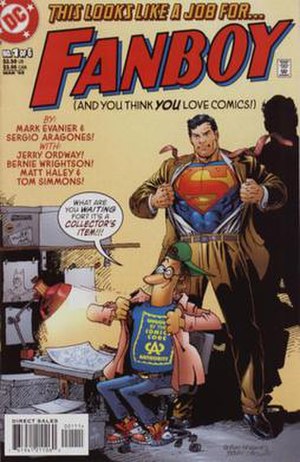

Image via Wikipedia
As I’ve mentioned before, I’m a bit of an Mark Evanier fanboy — and with Sergio Aragonés, I don’t think “fanboy” is a strong enough word. And I gather both of them deserve it, too — not only are both very talented, Mark Evanier seems like a good guy and, well, I’ve met Sergio, and I can confirm that he’s just about the sweetest man in the world. (One of my favorite examples is how at the comic convention I met him at, my dad wandered by the Sergio autograph line and overheard one of the con workers ask if Sergio wanted to take a break, and Sergio looked at him kind of baffled and said “Well, no, of course not, there’re all these people here to see me.”)
The niceness of the authors comes through in Fanboy, a collected trade paperback edition of the DC miniseries. The story follows Finster, a nebbishy, high-school age comics fan through life; if it were longer, it’d probably be a coming-of-age type of tale — as is, it’s a nice little book — particularly aimed at a younger crowd to help ’em through. Of course, there’s enough full-bore comics geekery to appeal to geeks of all ages, both of the same age as Finster as well as folks who can remember when they were that age. And, it doesn’t hurt that about half of each issue is co-illustrated by Sergio and various comics greats — including a Green Lantern-based story with Gil Kane.
My favorite issue is probably the Batman one, where each page or two is drawn by a different Batman artist in the morphing styles — including Dick Sprang, Jim Mooney, Joe Giella, Neal Adams, Frank Miller and Bruce Timm — along with corresponding Batman attitude changes. A close second is the war comic (done with Russ Heath), which ends up going into a history of the comics scandal of the 1950s, focusing on Bill Gaines‘ testimony… as drawn by Marie Severin, who worked at EC during their heyday as their colorist! For a comics geek, that’s a particular joy, seeing her doing the artwork for something she was actually there to see, with her friends as the particulars. The interesting thing, too, is that the Wertham stand-in is given a sympathetic treatment by mentioning that his point-of-view eventually changed — which Evanier fleshes out in his book Wertham Was Right!, an essential read for comics geeks.
Fanboy might not be as unforgettable as the most famous Evanier/Aragonés collaboration Groo The Wanderer, but it is a fun, good-natured read. I’d particularly recommend it for a young, fledgling geek who’s feeling down-on-themselves for their geekitude — both to help them feel better… and as a helpful guide to what traps to avoid in growing up geeky!
